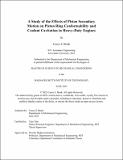| dc.contributor.advisor | Tian, Tian | |
| dc.contributor.author | Bradt, Casey S. | |
| dc.date.accessioned | 2023-08-23T16:15:18Z | |
| dc.date.available | 2023-08-23T16:15:18Z | |
| dc.date.issued | 2023-06 | |
| dc.date.submitted | 2023-07-19T18:45:07.612Z | |
| dc.identifier.uri | https://hdl.handle.net/1721.1/151870 | |
| dc.description.abstract | The transportation sector accounts for a significant share of global greenhouse gas emissions. There are a few particular modes of transportation such as shipping and long-haul trucking, which are dominated by heavy-duty diesel piston engines, that are more difficult to electrify or decarbonize via other alternatives. Because of this, environmental goals for those transportation modes is on two goals: reducing emissions and improving fuel efficiencies for existing internal combustion engine technologies. The work here presented is in two parts, each related to these two design goals.
As future designs aspire to reduce emissions, lubricating oil consumption (LOC) is a primary concern because it is a main emissions source. Bore distortion has arguably the largest effect on LOC due to its influence on piston ring-bore conformability. Thermal distortion and out-of-roundness of the cylinder caused by head bolt stresses are routinely considered in conformability analyses for ring pack designs. However, the effect of piston impact on the bore distortion for ring-liner conformability analyses has not been addressed, even though the magnitude of the piston impact distortions can be as high as those from thermal distortions. This piston impact effect was added to existing bore distortion and ring-liner conformability analysis techniques in the work documented here. The simulation workflow incorporated piston secondary motion and oil transport, transient structural finite element analysis of the cylinder, and a curved beam ring-liner conformability model. Significantly higher ring-liner clearance and higher contact were observed. As a result, higher oil leakage, wear, and combustion gas blow-by may become substantial and design adjustments may be warranted.
Separately, in attempt to achieve improved fuel efficiency, design efforts are often opposed by obstacles like durability issues. One such durability issue is cavitation erosion in wet liner engines. Cavitation erosion can cause tremendous damage and is often caused by vibrations in the liner driven by piston slap and other piston secondary motions. Piston secondary motion intensifies with many design trends aimed at increasing engine efficiency such as elevated combustion pressures and reduced structural weight. Thus, cavitation erosion acts as a barrier to higher efficiency designs. To prevent cavitation erosion, designers generally must find solutions based on engineering intuition paired with experiment, often sacrificing frictional performance. The work here documented developed a physics-based modeling and simulation capability to predict cavitation erosion during the design process and hopefully help overcome this barrier. A piston secondary motion software with consideration of oil transport was first used to calculate piston impact pressures. These impact pressures were then mapped to a coupled structure and fluids model of the liner and water jacket in Ansys. The developed Ansys model may employ either a one way or two-way structure-fluids coupling. A preliminary parametric study was also done to investigate the influence of various piston design parameters on the cavitation behavior. | |
| dc.publisher | Massachusetts Institute of Technology | |
| dc.rights | In Copyright - Educational Use Permitted | |
| dc.rights | Copyright retained by author(s) | |
| dc.rights.uri | https://rightsstatements.org/page/InC-EDU/1.0/ | |
| dc.title | A Study of the Effects of Piston Secondary Motion on Piston Ring Conformability and Coolant Cavitation in Heavy-Duty Engines | |
| dc.type | Thesis | |
| dc.description.degree | S.M. | |
| dc.contributor.department | Massachusetts Institute of Technology. Department of Mechanical Engineering | |
| dc.identifier.orcid | 0000-0002-8436-4412 | |
| mit.thesis.degree | Master | |
| thesis.degree.name | Master of Science in Mechanical Engineering | |
